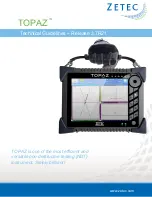
8 S&C Instruction Sheet 663-500
Shipping and Handling
Inspection
Examine the shipment for external evidence of damage as
soon after receipt as possible, preferably before removal
from the carrier’s conveyance. Check the bill of lading to
make sure all listed shipping skids, crates, and containers
are present.
If there is visible loss and/or damage:
1. Notify the delivering carrier immediately.
2. Ask for a carrier inspection.
3. Note condition of shipment on all copies of the delivery
receipt.
4. File a claim with the carrier.
If concealed damage is discovered:
1. Notify the delivering carrier within 15 days of receipt of
shipment.
2. Ask for a carrier inspection.
3. File a claim with the carrier.
Also, notify S&C Electric Company in all instances of
loss or damage.
Packing
S&C Source-Transfer PMH Pad-Mounted Gear is fastened
to a wood skid for shipment. Any components specified,
such as fuses, refill units, fuse holders, end fittings, etc.,
are packed separately and shipped within the enclosure
if they fit.
At the first opportunity, remove all packing materials
(cardboard, paper, foam padding, etc.) from the outside of
the gear. This will prevent the finish from being damaged
by rainwater absorbed by the packing materials and will
also prevent wind-induced abrasion from loose cardboard.
Storage
S&C Source-Transfer PMH Pad-Mounted Gear should
installed and energized immediately. When the gear is
energized, voltage sensor secondary-burden resistors
generate sufficient heat to help prevent condensation in
the low-voltage control compartment. If the gear cannot be
installed immediately, store it in a clean, warm, dry room.
Handling
WARNING
When handling the gear with an overhead hoist,
observe standard lifting practices as well as the
following general instructions .
Failure to follow these precautions can result in injury
and equipment damage .
Follow these steps to lift and move the pad-mounted gear:
STEP 1.
Make sure the lifting tabs are securely bolted to
the enclosure before lifting the gear.
STEP 2.
Use 6-foot (183-cm) or longer hoist slings of
equal length to prevent overstressing the
enclosure during lifting.
WARNING
Because the side of the gear where the low-voltage
control compartment is located is heavier than the
other side, the gear will tilt when lifting .
Therefore, care must be taken when lifting the gear
to avoid injury and equipment damage .
STEP 3.
Arrange the hoist slings to distribute the lifting
forces equally between the lifting tabs. See
Figure 1.
STEP 4.
Avoid sudden starts and stops.
Figure 1. The hoist sling arrangement.
Low-voltage control
compartment





































